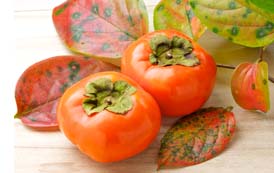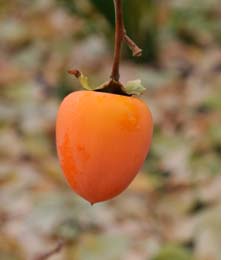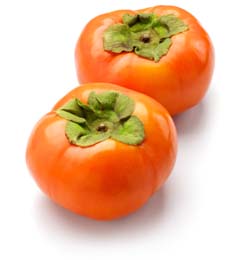Persimmon
- By FruitGuys Staff
- Reading Time: 2 mins.

A herald of winter in many regions is the persimmon. Where the rain or even sleet has begun, the bare persimmon tree, with its orange ornaments, makes a striking silhouette against the grey horizon. These fruits can stand a chill; as the old farmer saying goes, “Persimmons grow where mangos fear to tread.”
The common persimmon is native to the United States. Loosely translated, the genus name Diospyros means “fruit of the gods,” and the species virginiana is named for the colony. It got its common name from the native Algonquian tribe’s word pessemmin or pasiminan, the root “min” meaning “fruit” or “berry.” When the pilgrims arrived ill-equipped for their quest and the Native Americans saved their lives by showing them many of the New World’s foods, vitamin C–rich persimmon was one of them. Over the centuries, waves of newcomers have brought other varieties of persimmon, including the Hachiya and Fuyu from Japan, which are now common nationwide and go by the botanical name Diospyros kaki.
How to tell the difference
 The Hachiya is the evocative one, acorn-shaped and vermillion-colored. It is not ripe until it is very soft, squishy, and swooning in its skin, with a jelly-like texture. Be patient, as they are terrible if the tannins have not mellowed. But they’re well worth the wait. The Zen Buddhists meditate on the Hachiya persimmon, waiting for it to change from bitter to sweet. It is a symbol of transformation from ignorance to wisdom.
The Hachiya is the evocative one, acorn-shaped and vermillion-colored. It is not ripe until it is very soft, squishy, and swooning in its skin, with a jelly-like texture. Be patient, as they are terrible if the tannins have not mellowed. But they’re well worth the wait. The Zen Buddhists meditate on the Hachiya persimmon, waiting for it to change from bitter to sweet. It is a symbol of transformation from ignorance to wisdom.

If you lean more toward instant gratification, then the non-astringent Fuyu persimmon may be for you. The oblate Fuyus looks like a hard tomato and can range from light to deep orange. They can be eaten peeled or like an apple with the skin (keep an eye out for occasional seeds). Fresh persimmon is a perky addition to any salad or a lovely snack all on its own.
Get tips for your office
Be an office hero!Preparation
Hachiyas are ripe when custard-soft. Many people love them raw, but they are thought of as the best persimmons for baking. Scoop out flesh, remove seeds, and puree for baking needs. Fuyus are generally eaten raw and on the firmer side, as soon as they give slightly to pressure. You can wait until they’re softer, but not as soft as Hachiyas.
Storage
Store at room temperature. Once ripe, they’ll keep in the fridge for a few days or in the freezer for up to a few months.


